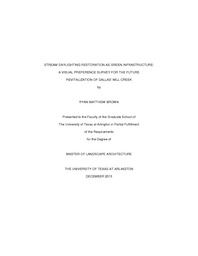| dc.description.abstract | The purpose of this research is to study the visual design elements of stream daylighting through a visual preference survey and apply them to a site along the Mill Creek flowline in Dallas, Texas. This research begins with a study on identifying a specific site location within the Mill Creek watershed. From that study, a visual preference survey determined which visual design elements of stream daylighting were found to be the most desirable. The most desirable visual design elements were then used to digitally depict a suggested stream daylighting outcome through the use of before and after images of the selected site. Before the 1960s, a common practice was to bury the smaller streams of watershed networks that were water sources for larger rivers, or headwaters, underground for industrial, transportation, and urban development reasons (American Rivers 2014). As a result of burying headwaters, there has been a steady increase of flooding hazards, water contamination and pollution, property damage, animal and plant habitat destruction, and loss of human life (American Rivers 2014; Halff Associates 2005; Koshaley 2008). However, an applicable technique to mitigate the aforementioned issues is called stream daylighting. Stream daylighting is the act of unearthing, restoring, and revitalizing buried waterways (American Rivers 2014; Koshaley 2008). Studies have shown that the success of a stream daylighting project is determined by the benefits the project provides. Human engagement, increased animal and plant life, increased property value, temperature reduction, improved water quality, reduced air and water pollution, and decreased crime are all potential benefits of stream daylighting, (American Rivers 2014; Downtown Kalamazoo, Inc. 2015; Groundwork Hudson Valley 2015; Mecklenburg County, North Carolina 2015). There are several studies measuring the success of stream daylighting, however, few studies have analyzed the visual design elements that could contribute to the success of a stream daylighting project. These elements include stream alignment, stream bank design, stream bank materials, stream bank slope, stream width, and water features. They also include how far the creek is from a roadway and how close the creek is to a pedestrian pathway. This study identifies a location and applies these elements to depict a possible stream daylighting scenario for the future. Mill Creek, a major underground perennial creek system that feeds into the Trinity River, is one of a few major creeks found in Dallas, Texas. Since Mill Creek was buried underground in the 1930s, the outdated and deteriorating piping system has created numerous infrastructure, safety, economic, pollution, and ecosystem complications (Halff Associates 2005). Due to these complications, this area is selected as the study area. Landscape architects, engineers, planners, and researchers can use the findings to not only guide similar studies but further guide similar projects in the area as well. The findings concluded that a braided and divided stream with a 10-20 foot width was very desirable for the area. The stream would include rocks and boulders along its banks with rippling and wave effects. An overtly designed planting scheme, immediately adjacent pathway, and distant roadway would help define the spatial edge of the stream.. | |


